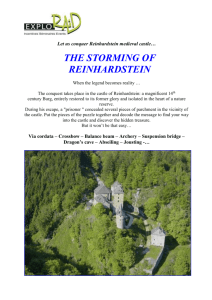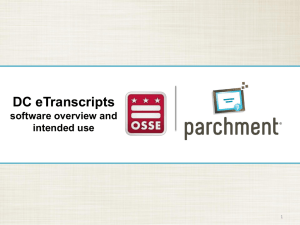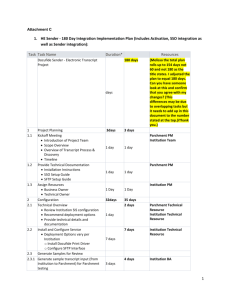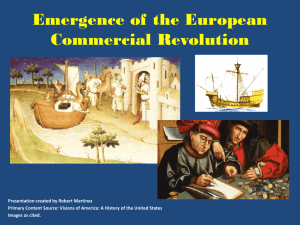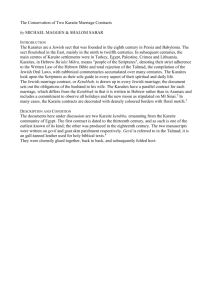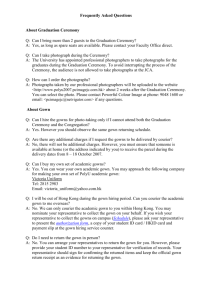Damage assessment of parchment by micro
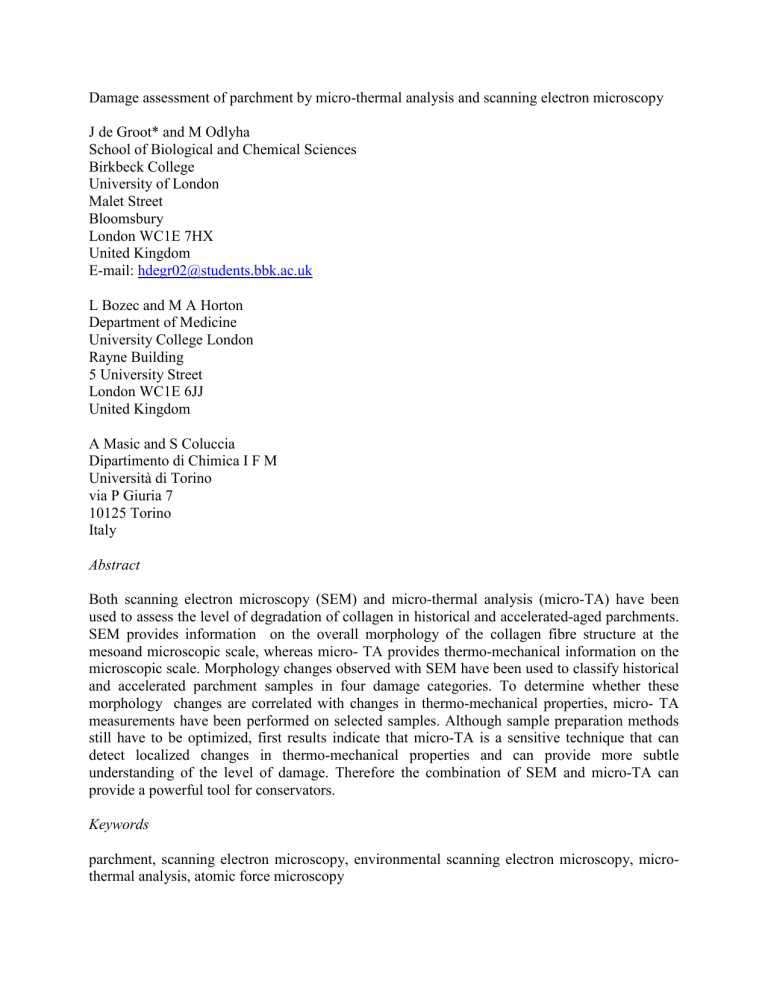
Damage assessment of parchment by micro-thermal analysis and scanning electron microscopy
J de Groot* and M Odlyha
School of Biological and Chemical Sciences
Birkbeck College
University of London
Malet Street
Bloomsbury
London WC1E 7HX
United Kingdom
E-mail: hdegr02@students.bbk.ac.uk
L Bozec and M A Horton
Department of Medicine
University College London
Rayne Building
5 University Street
London WC1E 6JJ
United Kingdom
A Masic and S Coluccia
Dipartimento di Chimica I F M
Università di Torino via P Giuria 7
10125 Torino
Italy
Abstract
Both scanning electron microscopy (SEM) and micro-thermal analysis (micro-TA) have been used to assess the level of degradation of collagen in historical and accelerated-aged parchments.
SEM provides information on the overall morphology of the collagen fibre structure at the mesoand microscopic scale, whereas micro- TA provides thermo-mechanical information on the microscopic scale. Morphology changes observed with SEM have been used to classify historical and accelerated parchment samples in four damage categories. To determine whether these morphology changes are correlated with changes in thermo-mechanical properties, micro- TA measurements have been performed on selected samples. Although sample preparation methods still have to be optimized, first results indicate that micro-TA is a sensitive technique that can detect localized changes in thermo-mechanical properties and can provide more subtle understanding of the level of damage. Therefore the combination of SEM and micro-TA can provide a powerful tool for conservators.
Keywords parchment, scanning electron microscopy, environmental scanning electron microscopy, microthermal analysis, atomic force microscopy
*Author to whom correspondence should be addressed
Introduction
Parchment is regarded as an important testimony of our cultural heritage. The surviving books and documents preserve accounts of events and ideas that have determined the development of civilization over many centuries. Arising from the need of conservators for improved damage assessment of parchment (IDAP) of historical parchment, both scanning electron microscopy
(SEM) and micro-thermal analysis (micro-TA) have been used to assess the level of degradation of collagen in historical and accelerated aged parchments. SEM provides information on the overall morphology of the collagen fibre structure at the meso- and microscopic scale, whereas micro-TA can combine imaging of the sample at the sub-micrometre level as well as providing analytical information relating to thermal transitions, which, for example, reflect degree of crosslinking and crystallinity in a sample. This combinatory technique allows a more subtle understanding of the level of damage present in a given parchment sample.
Material and methods
Parchment is processed animal skin from mostly large, edible animals such as calf, goat, sheep and reindeer and consists mainly of the fibrous hide protein collagen (Larsen et al. 2003). In parchment collagen forms fibres that are approximately 50–300 μm micron in diameter with generally larger fibre diameters in the flesh side compared to grain side. These collagen fibres consist of tightly packed fibrils that exhibits a characteristic periodicity (64–67 nm) and are stabilized by intra and intermolecular cross-links and hydrogen bonds. Under unfavourable storage conditions these links can be broken, leading to reduction of hydrothermal stability and deterioration of the collagen structure (Wright et al. 2002). Heat, humidity, light and air pollutants NO x and SO2 can cause such unfavourable storage conditions (Larsen et al. 2004). To quantify the effect of these unfavourable storage conditions, several sets of accelerated aged samples have been prepared as part of the European IDAP project (Larsen et al. 2004). These parchments form part of the IDAP parchment database that also consists of several historical samples. All parchment samples described in this article are selected parchments from this database and are described in more detail in table 1.
Table 1. Samples used, selected from the IDAP parchment database (Larsen et al. 2004)
Scanning electron microscopy
Both conventional and environmental scanning electron microscopy (SEM/ESEM) have been used to assess the state of collagen fibres and morphological changes in reference, accelerated
aged and historical parchment samples from the IDAP project (Larsen et al. 2004). By comparison of images obtained from SEM and ESEM it was possible to establish that the coating process necessary for SEM imaging does not induce any damage to the parchment samples.
Given the limited access to the ESEM, SEM has been used whenever conservators did not require the recovery of the parchment sample.
Micro-thermal analysis
Micro-thermal analysis has the same working principle as atomic force microscopy (AFM) in that a small tip is scanned over the surface. In micro-TA a Wollaston heating probe is used, which behaves as a small resistance heater as well as a conventional AFM tip (Pollock et al. 2001). The power required to maintain the tip at a constant temperature can be monitored as it is scanned across the specimen and used to build up an image based on the variation in apparent thermal contrast. This probe can also be used to measure the tip deflection while ramping the heat linearly and so provides values for thermal transitions of (bio)-polymers (Pollock et al. 2001). Thermal transitions in unaged and historical parchment have been previously measured using dynamic mechanical thermal analysis (DMTA) and their origin discussed in terms of changes in the amino acid residue composition (Odlyha et al. 2002). Some preliminary results were also shown using micro-TA and it was suggested that transitions observed at the macro-scale (DMTA) could also be observed at the micro-scale which provides the possibility of studying archival samples where sampling is restricted or not possible.
Experimental
Scanning electron microscopy
Parchment samples were observed in an environmental scanning electron microscope Philips XL
30 ESEM and scanning electron microscope Leica Stereoscan 420. With this, ESEM samples can be examined in an atmosphere of up to 10 torr of water vapour or any other non-corrosive gas and samples can be non-conducting. For each parchment areas of 9 mm
2
were cut out with a scalpel. Each sample was fixed to a double-sided carbon disc tape that was attached to a standard
SEM Al stub. One sample was placed with the flesh side up, the other with the grain side up.
After this step, samples were ready for ESEM imaging. For SEM imaging, the samples were carbon coated.
Micro-thermal analysis
Micro-thermal analysis requires a smooth surface with a surface variation smaller than 10 μm over a 100 μm × 100 μm area. Because parchment is relatively rough,
10 μm cross-sections are cryotomed at –20 °C from 2 mm 2
parchment samples with a disposable stainless steel knife. Samples were embedded in OCT, a water soluble glycol, and cut perpendicular to the head-tail direction. Directly after cutting the cross-section, the cross-section was mounted on a cover glass that was attached to a standard AFM holder and stored at room temperature. The thin sections were visually inspected with an optical microscope and the two best cross-sections were selected for further measurements. For each cross-section an area of 50
μm × 50 μm on the flesh side was scanned. During this scan, a topographic and thermal contrast
image was recorded simultaneously. After each scan localized thermal analysis measurements were performed on the scanned area by linearly ramping the temperature from 20 to 150 °C at 5
°C/s while measuring the tip deflection (the applied force is typically several micronewtons).
Between two different experiments, localized thermalanalysis measurements for reference sample
SC81:5 were repeated to determine the measurement repeatability. During the described experiments changes in sensor deflection at any given temperature remained within 25 per cent.
Therefore any change in thermo-mechanical response larger than 25 per cent was quite probably caused by a change in material properties. The Wollaston wire probe was calibrated with the melting points of standards used in this technique, for example polycaprolactone ( T m
= 58 °C), polymethylmethacrylate (PMMA) ( T m
= 150 °C) and Nylon 6,6 ( T m
= 250 °C) and the calibration was checked between experiments with the melting point of PMMA. For all experiments described in this paper the calibration was found to be within 5 °C of the original calibration.
Artifacts introduced by sample preparation
To determine whether the described sample preparation method was introducing damage and artefacts to the samples, AFM was used to image the surface of crosssections and fibres from the reference sample SC81:5. The fibres were scraped off from the flesh side of SC81:5 and placed on a microscope slide. A drop of distilled water was applied onto the fibres and after drying, the fibres were fixed to the microscope slide. Both the cross-section and parchment fibres are imaged in contact mode with a JPK atomic force microscope ( JPK, Berlin, Germany).
Experimental results
Scanning electron microscopy
New untreated parchments showed integral collagen fibres with clean contours and sharp edges
(Figure 1a). Small changes have been observed in samples exposed for 32 days to 80 °C and 40 per cent relative humidity (RH) (SC155, Figure 2). However, remarkable changes were observed for accelerated aged parchment that have been exposed for 2, 4, 8 and 16 days at 80 °C and 80 per cent RH (SC102–SC107) (Figure 1). A progressive loss of fibrous network could be observed that started as a swelling of fibres (Figure 1b, c), continued by a superficial ‘melting’ effect
(Figure 1d, e) and then proceeded towards a glass-like surface that started to fragment in the final phase of degradation (Figure 1f ). The fibrous network was still visible under the superficial layer and indicated that the damage was limited to a thin surface layer (Figure 1f ). The surface morphological aspects of historical parchments proved to be much more heterogeneous compared with accelerated aged parchments. Therefore, observations made on the accelerated aged samples have been used to identify aging related morphological aspects in historical parchments. Two morphological indexes have been defined: index I is used to assess the intactness of the fibrous network, whereas index II is used to assess glass-like surfaces. In each case, values from 1 to 4 have been assigned considering the following criteria:
Index I: fibre network:
1 well-visible fibrous network and fibres with clean contours
2 swollen and rounded off fibres
Figure 1. Environmental scanning electron micrographs illustrating morphological changes induced by heating (80 °C) and relative humidity (80 per cent): (a) unaged parchment, intact fibre network (reference sample); (b) swollen fibres (2 days aged); (c) higher proportion of swollen fibres (4 days aged); (d) drastic morphological changes, glass-like surfaces have appeared (8 days aged); (e) higher magnification of sample in (d), melting of fibres observed; ( f
) extended glass-like surface with cracks, detaching of surface deteriorated layer (16 days)
Figure 2. Scanning electron micrographs illustrating: (a) slightly damaged parchment (SC155) with swollen fibres; (b) extended glass-like surface with deep cracks of a very damaged parchment (SC173:2)
3 globular aspect, but still visible fibres network 4 disappearing of the fibrous network.
Index II: glass-like surfaces and cracks:
1 incipient presence of glass-like surfaces
2 extended glass-like surface morphology
3 glass-like surfaces with cracks
4 deeply fragmented structure with granular aspect.
The average value of the two assigned damage indexes was used for classification of the historical parchments into four categories: undamaged, lightly damaged, damaged and severely damaged.
Micro-thermal analysis
Local thermal analysis of SC81:5, an unaged, commercially available parchment, showed two stages in thermo-mechanical response: expansion from room temperature until 70–90 °C followed by softening of the sample observed as a downward deflection. In samples SC155, aged at 80 °C and 40 per cent RH for 32 days (Figure 3b), and SC173:2 (Figure 3d), a historical bookbinding, some locations have similar thermo-mechanical behaviour compared with the unaged parchment SC81:5. However, other locations showed different thermomechanical behaviour. For sample SC155 differences occurred in the less
Figure 3. Micro-thermal analysis results (displacement (micrometres) vs. temperature (degrees celsius)). Clockwise from left: SC81:5 (unaged parchment), SC155 (aged at 80 °C and 40 per cent RH for 32 days), CR17 (aged at 50 ppm NO
2
for 16 days) and SC173:2 (historical bookbinding from Archivo di Stato, Florence) pronounced softening (curves 1 and 2) and for sample SC173:2 differences occurred both in the expansion and the softening (curves 1 & 2). In sample CR17 (Figure 3c), aged 16 weeks with
NO
2
(50 parts per million (ppm)) and 50 per cent RH, the expansion is smaller for all curves with either no softening (curves 3 and 4) or softening already starting around 30 °C for curves 1 and 2.
These results seem to suggest that there are two independent damage processes that influence either the expansion or softening (see curve 2 in sample SC173:2 and curves 1 and 2 in sample
SC155). The process that reduces the expansion might be associated with increased cross-linking whereas the process affecting the softening might be associated with gelatinization. More measurements are required to determine whether these hypotheses are correct; however, these initial results suggest that micro-thermal measurements could give a more subtle understanding of the damage compared to ESEM imaging only. The measurements were conducted on the flesh side of the cross-section andthis has been shown to contain calcium carbonate, either formed from the original liming process used it its preparation or subsequently added to improve the writing surface (Odlyha et al. 2002). The distribution of calcium carbonate within the sample will also affect the softening temperatures. For this purpose, thermal conductivity imaging was used to evaluate this contribution. However, so far the cross-sections have had topographical features of several microns of height in a scan area of 2500 μm
2
. As the measured thermal contrast is a strong convolution between topography and real thermal contrasts, apparent changes in thermal contrast within the cross-sections could therefore either have been caused by different material properties or changes in topography (Pollock et al.2001).
Artifacts in sample preparation
An AFM error image obtained from a parchment fibre of sample SC81:5 clearly shows an almost intact fibril structure and axial repeat; however, this structure is not clearly visible in an AFM error image of a cross section of SC81:5 (Figure 4)
Figure 4. AFM error image of a parchment fibre (left-hand side) from sample SC81:5 (unaged parchment) and AFM error image of a cross-section of the same sample (right-hand side). An error image is equivalent to the derivative of the topography image and is given here because it has more contrast than the original topography image
(error images are equivalent to the derivative of topography images and are shown here since they show more contrast than the original topography images). These measurements clearly show that the used sample preparation method is introducing damage to the parchment. Therefore, at time of submission of this article, new localized thermal analysis experiments on parchment fibres are under development.
Conclusions
SEM imaging has been successfully used to identify aging related topography changes in the parchment surface of accelerated aged and historical samples. These changes have been used to classify parchment in four different damage categories. Furthermore, glass-like surfaces and their fragility have been identified, showing that parchments with glass-like surfaces have to be handled with extra care since mechanical handling can lead to flaking of the surface. Micro-TA results are still in the exploratory phase, particularly for the optimization of the sample preparation. Results on thin sections showed that aging related changes in thermo-mechanical behaviour could be detected that correlated well with shrinkage temperatures (Larsen et al. 2005) and the observation of glass-like surfaces in SEM. Furthermore, this technique could detect subtle differences in damage that suggest the presence of different damage pathways. Although more measurements are required to increase understanding about these processes, the first measurements show the potential of micro-TA. AFM has been used to complement micro-TA with positive results. It has shown that the axial repeat (Figure 4) in collagen fibres can be measured on sample with little sample preparation and care must be taken when considering preparation of cross-sections as damage can be introduced. In the next stage of the work will focus on micro-TA on fibres possibly immobilized in novel ways without the use of drops of water. The advantage of combining information from SEM, micro-TA and AFM is that information is not only obtained about the state of the collagen fibres, but also the fibrils (Larsen et al. 2005) where deviations from the axial repeat can be quantified (de Groot et al. 2004). In addition, localized thermal mechanical information can be obtained, which has previously shown a relationship to the chemical state of parchment (Odlyha et al. 2002). If SEM and micro-TA were used independently, neither technique would give an accurate description of the damage;
SEM observations show that the damage distribution is not uniform throughout the sample and therefore measurements of the surface or cross-section alone would not provide a complete description of the damage. However, by combining the results of these two complementary techniques, a more accurate description of the damage can be provided and therefore the combination of micro-TA and SEM could provide a powerful tool for damage assessment for conservation and could provide more understanding about the damage processes.
Acknowledgements
We are grateful to the European Commission for funding this project under the 5th Framework program Energy, Environment and Sustainable Development (EESD), key action 4: ‘The City of
Tomorrow and Cultural Heritage’, subsection 4.2.1 ‘Improved damaged assessment of cultural heritage’, contractnumber EVK4-CT-2001-00061.
References
De Groot, J, Bozec, L, Horton, M and Odlyha, M, 2004, in preparation.
Larsen, R, 2002, Microanalysis of Parchment, European Project SMT4-CT96-2106 ,
Archetype publications.
Larsen, R, et al., 2004, ‘Improved damage assessment of parchment (IDAP)’, European project EVK4-CT-2001-00061, http://www.idap-parchment.dk.
Larsen, R, et al., 2005, ‘Damage assessment of parchment: complexity and relations at different structural levels’, in
ICOM Committee for Conservation, The Hague, Working
Group on Graphic Documents .
Pollock, H M and Hammiche, A, 2001, ‘Topical review micro-thermal analysis: techniques and applications’,
Journal of Physics D: Applied Physics 34, R23–R53.
Odlyha, M, Cohen, N, Foster, G and Campana, R, 2002, ‘Microanalysis of parchment
(European project SMT4-CT96-2106), Chapter 9, Characterization of historic and unaged parchments using thermomechanical and thermogravimetric techniques’,
Archetype Publications, 93–99.
Odlyha, M, Cohen, N S, Foster, G M and Aliev, A, 2002, ‘Assessment of the state of degradation of historical parchment by dynamic mechanical thermal analysis (DMTA) and solid state 13C NMR’, in
Preprints of the 13th Triennial Meeting ICOM Committee for Conservation, volume 1, Rio de Janeiro September , London, James and James, 615–621.
Odlyha, M, Cohen, N S, Foster, G M, Aliev, A, Verdonck, E and Grandy, D, 2003,
‘Dynamic mechanical analysis (DMA), 13C solid state NMR and micro-thermomechanical studies of historical parchments’,
Journal of Thermal Analysis and Calorimetry
71, 939–950.
Wright, N T and Humphrey, J D, 2002, ‘Denaturation of collagen via heating: an irreversible rate process’,
Annual Review of Biomedical Engineering 219, 109–128.
Materials
Parchment manufacturer
Z H de Groot
Heemsradesingel 255a
3023 CE Rotterdam
The Netherlands
